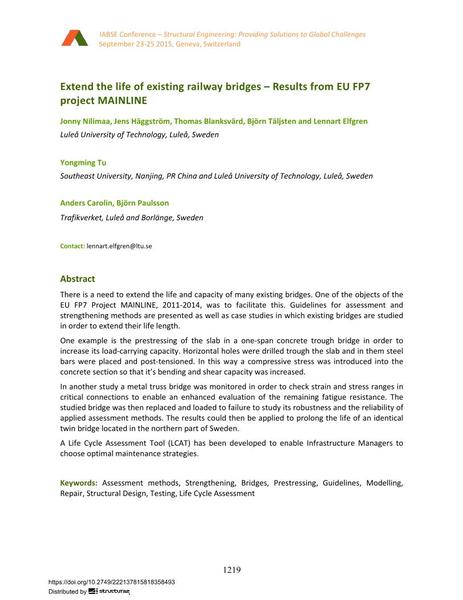Extend the life of existing railway bridges – Results from EU FP7 project MAINLINE

|
|
|||||||||||
Bibliografische Angaben
| Autor(en): |
Jonny Nilimaa
(Luleå University of Technology, Luleå, Sweden)
Jens Häggström (Luleå University of Technology, Luleå, Sweden) Thomas Blanksvärd (Luleå University of Technology, Luleå, Sweden) Björn Täljsten (Luleå University of Technology, Luleå, Sweden) Lennart Elfgren Yongming Tu (Southeast University, Nanjing, PR China and Luleå University of Technology, Luleå, Sweden) Anders Carolin (Trafikverket, Luleå and Borlänge, Sweden) Björn Paulsson (Trafikverket, Luleå and Borlänge, Sweden) |
||||
|---|---|---|---|---|---|
| Medium: | Tagungsbeitrag | ||||
| Sprache(n): | Englisch | ||||
| Tagung: | IABSE Conference: Structural Engineering: Providing Solutions to Global Challenges, Geneva, Switzerland, September 2015 | ||||
| Veröffentlicht in: | IABSE Conference Geneva 2015 | ||||
|
|||||
| Seite(n): | 1219-1226 | ||||
| Anzahl der Seiten (im PDF): | 8 | ||||
| Jahr: | 2015 | ||||
| DOI: | 10.2749/222137815818358493 | ||||
| Abstrakt: |
There is a need to extend the life and capacity of many existing bridges. One of the objects of the EU FP7 Project MAINLINE, 2011-2014, was to facilitate this. Guidelines for assessment and strengthening methods are presented as well as case studies in which existing bridges are studied in order to extend their life length. One example is the prestressing of the slab in a one-span concrete trough bridge in order to increase its load-carrying capacity. Horizontal holes were drilled trough the slab and in them steel bars were placed and post-tensioned. In this way a compressive stress was introduced into the concrete section so that it’s bending and shear capacity was increased. In another study a metal truss bridge was monitored in order to check strain and stress ranges in critical connections to enable an enhanced evaluation of the remaining fatigue resistance. The studied bridge was then replaced and loaded to failure to study its robustness and the reliability of applied assessment methods. The results could then be applied to prolong the life of an identical twin bridge located in the northern part of Sweden. A Life Cycle Assessment Tool (LCAT) has been developed to enable Infrastructure Managers to choose optimal maintenance strategies. |
||||
| Stichwörter: |
Tragwerksentwurf Brücken Modellbildung Lebenszyklusanalyse Richtlinien Verstärkung Reparatur Vorspannung Bewertungsmethoden
|
||||

